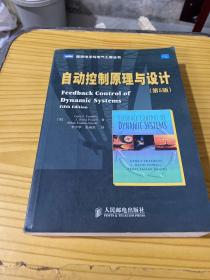
自动控制原理与设计(第八版)(英文版)
¥ 60 3.6折 ¥ 169 九五品
仅1件
江苏苏州
认证卖家担保交易快速发货售后保障
作者[美]Gene F. Franklin (吉恩 · F. 富兰克林
出版社电子工业出版社
出版时间2021-01
版次1
装帧其他
货号s3-1
上书时间2024-07-12
- 最新上架
商品详情
- 品相描述:九五品
- 没拆塑封,塑封轻有开裂现象。
图书标准信息
- 作者 [美]Gene F. Franklin (吉恩 · F. 富兰克林
- 出版社 电子工业出版社
- 出版时间 2021-01
- 版次 1
- ISBN 9787121404061
- 定价 169.00元
- 装帧 其他
- 开本 其他
- 纸张 胶版纸
- 页数 904页
- 【内容简介】
- 本书是自动控制领域的经典著作,以自动控制系统的分析和设计为主线,在回顾自动控制系统动态响应和反馈控制的基本特性基础上,重点介绍了自动控制系统的3种主流设计方法:根轨迹设计方法、频率响应设计方法和状态空间设计方法。此外,还阐述了非线性系统的分析与设计,给出了汽车发动机、无人机、半导体晶圆制造等应用的控制系统设计实例。全书在阐述自动控制原理和设计方法的过程中,适时地穿插了MATLAB仿真源代码和仿真实验结果。
- 【作者简介】
-
Gene F. Franklin,美国斯坦福大学电气工程系教授。国际著名控制学家,IEEE终身会士。于1955年在哥伦双亚大学获得博士学位,曾任斯坦福大学电气工程系主任、IEEE控制系统学会理事、副主席,其研究领域覆盖了控制和各个方面。2005年因其对多个控制领域的基础性贡献而美国自动控制学会最高奖Bellman奖。
Gene F. Franklin,美国斯坦福大学电气工程系教授。国际著名控制学家,IEEE终身会士。于1955年在哥伦双亚大学获得博士学位,曾任斯坦福大学电气工程系主任、IEEE控制系统学会理事、副主席,其研究领域覆盖了控制和各个方面。2005年因其对多个控制领域的基础性贡献而美国自动控制学会最高奖Bellman奖。 - 【目录】
-
Chapter 1 An Overview and Brief History of Feedback Control
A Perspective on Feedback Control
Chapter Overview
1.1 A Simple Feedback System
1.2 A First Analysis of Feedback
1.3 Feedback System Fundamentals
1.4 A Brief History
1.5 An Overview of the Book
Summary
Review Questions
Problems
Chapter 2 Dynamic Models
A Perspective on Dynamic Models
Chapter Overview
2.1 Dynamics of Mechanical Systems
2.1.1 Translational Motion
2.1.2 Rotational Motion
2.1.3 Combined Rotation and Translation
2.1.4 Complex Mechanical Systems (W)①
2.1.5 Distributed Parameter Systems
2.1.6 Summary: Developing Equations of Motion for Rigid Bodies
2.2 Models of Electric Circuits
2.3 Models of Electromechanical Systems
2.3.1 Loudspeakers
2.3.2 Motors
△ 2.3.3 Gears
△ 2.4 Heat and Fluid-Flow Models
2.4.1 Heat Flow
2.4.2 Incompressible Fluid Flow
2.5 Historical Perspective
Summary
Review Questions
Problems
Chapter 3 Dynamic Response
A Perspective on System Response
Chapter Overview
3.1 Review of Laplace Transforms
3.1.1 Response by Convolution
3.1.2 Transfer Functions and Frequency Response
3.1.3 The ?_ Laplace Transform
3.1.4 Properties of Laplace Transforms
3.1.5 Inverse Laplace Transform by Partial-Fraction Expansion
3.1.6 The Final Value Theorem
3.1.7 Using Laplace Transforms to Solve Differential Equations
3.1.8 Poles and Zeros
3.1.9 Linear System Analysis Using Matlab
3.2 System Modeling Diagrams
3.2.1 The Block Diagram
3.2.2 Block-Diagram Reduction Using Matlab
3.2.3 Mason’s Rule and the Signal Flow Graph (W)
3.3 Effect of Pole Locations
3.4 Time-Domain Specifications
3.4.1 Rise Time
3.4.2 Overshoot and Peak Time
3.4.3 Settling Time
3.5 Effects of Zeros and Additional Poles
3.6 Stability
3.6.1 Bounded Input-Bounded Output Stability
3.6.2 Stability of LTI Systems
3.6.3 Routh’s Stability Criterion
△ 3.7 Obtaining Models from Experimental Data: System Identification (W)
△ 3.8 Amplitude and Time Scaling (W)
3.9 Historical Perspective
Summary
Review Questions
Problems
Chapter 4 A First Analysis of Feedback
A Perspective on the Analysis of Feedback
Chapter Overview
4.1 The Basic Equations of Control
4.1.1 Stability
4.1.2 Tracking
4.1.3 Regulation
4.1.4 Sensitivity
4.2 Control of Steady-State Error to Polynomial Inputs: System Type
4.2.1 System Type for Tracking
4.2.2 System Type for Regulation and Disturbance Rejection
4.3 The Three-Term Controller: PID Control
4.3.1 Proportional Control (P)
4.3.2 Integral Control (I)
4.3.3 Derivative Control (D)
4.3.4 Proportional Plus Integral Control (PI)
4.3.5 PID Control
4.3.6 Ziegler-Nichols Tuning of the PID Controller
4.4 Feedforward Control by Plant Model Inversion
△ 4.5 Introduction to Digital Control (W)
△ 4.6 Sensitivity of Time Response to Parameter Change (W)
4.7 Historical Perspective
Summary
Review Questions
Problems
Chapter 5 The Root-Locus Design Method
A Perspective on the Root-Locus Design Method
Chapter Overview
5.1 Root Locus of a Basic Feedback System
5.2 Guidelines for Determining a Root Locus
5.2.1 Rules for Determining a Positive (180°) Root Locus
5.2.2 Summary of the Rules for Determining a Root Locus
5.2.3 Selecting the Parameter Value
5.3 Selected Illustrative Root Loci
5.4 Design Using Dynamic Compensation
5.4.1 Design Using Lead Compensation
5.4.2 Design Using Lag Compensation
5.4.3 Design Using Notch Compensation
△ 5.4.4 Analog and Digital Implementations (W)
5.5 Design Examples Using the Root Locus
5.6 Extensions of the Root-Locus Method
5.6.1 Rules for Plotting a Negative (0°) Root Locus
△ 5.6.2 Successive Loop ClosureS
△ 5.6.3 Time Delay (W)
5.7 Historical Perspective
Summary
Review Questions
Problems
Chapter 6 The Frequency-Response Design Method
A Perspective on the Frequency-Response Design Method
Chapter Overview
6.1 Frequency Response
6.1.1 Bode Plot Techniques
6.1.2 Steady-State Errors
6.2 Neutral Stability
6.3 The Nyquist Stability Criterion
6.3.1 The Argument Principle
6.3.2 Application of The Argument Principle to Control Design
6.4 Stability Margins
6.5 Bode’s Gain-Phase Relationship
6.6 Closed-Loop Frequency Response
6.7 Compensation
6.7.1 PD Compensation
6.7.2 Lead Compensation (W)
6.7.3 PI Compensation
6.7.4 Lag Compensation
6.7.5 PID Compensation
6.7.6 Design Considerations
△ 6.7.7 Specifications in Terms of the Sensitivity Function
△ 6.7.8 Limitations on Design in Terms of the Sensitivity Function
△ 6.8 Time Delay
6.8.1 Time Delay via the Nyquist Diagram (W)
△ 6.9 Alternative Presentation of Data
6.9.1 Nichols Chart
6.9.2 The Inverse Nyquist Diagram (W)
6.10?Historical Perspective
Summary
Review Questions
Problems
Chapter 7 State-Space Design
A Perspective on State-Space Design
Chapter Overview
7.1 Advantages of State-Space
7.2 System Description in State-Space
7.3 Block Diagrams and State-Space
7.4 Analysis of the State Equations
7.4.1 Block Diagrams and Canonical Forms
7.4.2 Dynamic Response from the State Equations
7.5 Control-Law Design for Full-State Feedback
7.5.1 Finding the Control Law
7.5.2 Introducing the Reference Input with Full-State Feedback
7.6 Selection of Pole Locations for Good Design
7.6.1 Dominant Second-Order Poles
7.6.2 Symmetric Root Locus (SRL)
7.6.3 Comments on the Methods
7.7 Estimator Design
7.7.1 Full-Order Estimators
7.7.2 Reduced-Order Estimators
7.7.3 Estimator Pole Selection
7.8 Compensator Design: Combined Control Law and Estimator (W)
7.9 Introduction of the Reference Input with the Estimator (W)
7.9.1 General Structure for the Reference Input
7.9.2 Selecting the Gain
7.10?Integral Control and Robust Tracking
7.10.1?Integral Control
△ 7.10.2?Robust Tracking Control: The Error-Space Approach
△ 7.10.3?Model-Following Design
△ 7.10.4?The Extended Estimator
△ 7.11?Loop Transfer Recovery
△ 7.12?Direct Design with Rational Transfer Functions
△ 7.13?Design for Systems with Pure Time Delay
7.14?Solution of State Equations (W)
7.15?Historical Perspective
Summary
Review Questions
Problems
Chapter 8 Digital Control
A Perspective on Digital Control
Chapter Overview
8.1 Digitization
8.2 Dynamic Analysis of Discrete Systems
8.2.1 z-Transform
8.2.2 z-Transform Inversion
8.2.3 Relationship Between s and z
8.2.4 Final Value Theorem
8.3 Design Using Discrete Equivalents
8.3.1 Tustin’s Method
8.3.2 Zero-Order Hold (ZOH) Method
8.3.3 Matched Pole-Zero (MPZ) Method
8.3.4 Modified Matched Pole-Zero (MMPZ) Method
8.3.5 Comparison of Digital Approximation Methods
8.3.6 Applicability Limits of the Discrete Equivalent Design Method
8.4 Hardware Characteristics
8.4.1 Analog-to-Digital (A/D) Converters
8.4.2 Digital-to-Analog Converters
8.4.3 Anti-Alias Prefilters
8.4.4 The Computer
8.5 Sample-Rate Selection
8.5.1 Tracking Effectiveness
8.5.2 Disturbance Rejection
8.5.3 Effect of Anti-Alias Prefilter
8.5.4 Asynchronous Sampling
△ 8.6 Discrete Design
8.6.1 Analysis Tools
8.6.2 Feedback Properties
8.6.3 Discrete Design Example
8.6.4 Discrete Analysis of
点击展开
点击收起
相关推荐
— 没有更多了 —





















以下为对购买帮助不大的评价